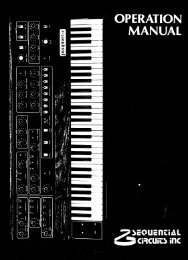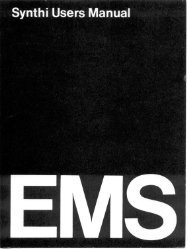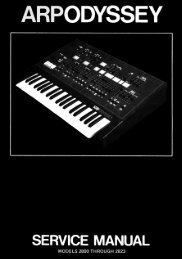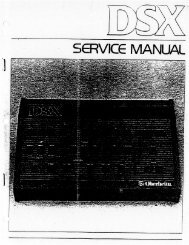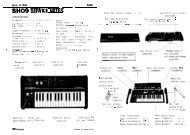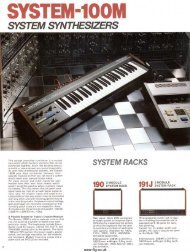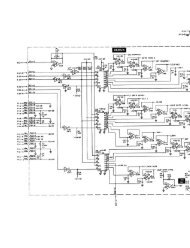ARP2600 - Fundamentals of Music Technology - Cyborgstudio.com
ARP2600 - Fundamentals of Music Technology - Cyborgstudio.com
ARP2600 - Fundamentals of Music Technology - Cyborgstudio.com
You also want an ePaper? Increase the reach of your titles
YUMPU automatically turns print PDFs into web optimized ePapers that Google loves.
SECTION TEN: S/H MODULE - 077It is also possible to trigger the EGs using the gate and trigger in jacks. The use <strong>of</strong> these jacks will bediscussed briefly in Section 15 when the ARP sequencer is introduced. However, unless the 2600 isgoing to be interfaced with other equipment, these jacks are not used nearly as much as an FM input ona VCO or even the output on the filter.THE ELECTRONIC SWITCHThe electronic switch is one <strong>of</strong> the most unique and <strong>of</strong>t forgotten parts <strong>of</strong> the 2600. It consists entirely<strong>of</strong> three jacks labeled A, B, and C. The electronic switch alternately connects jack C to jack A and jackB. When A is connected to C, B is disconnected from C, and vise versa.The internal clock is permanently normalled to the electronic switch, and determines the electronicswitch’s rate <strong>of</strong> switching. One may recall that the internal clock was described as putting out a series<strong>of</strong> trigger pulses which drive a square wave oscillator, and it is this square wave which drives theelectronic switch. The 2600’s designers thoughtfully indicated this with a rather long square wave nextto the line indicating the internal clock’s normal to the electronic switch. (See Figure 10-2 on page 75.)It is interesting to note that the electronic switch’s jacks are neither specifically inputs nor outputs. Forinstance, one could connect the output <strong>of</strong> an oscillator to jack A, and it would <strong>com</strong>e out jack C when theelectronic switch connected the two. One could also connect the output <strong>of</strong> an oscillator to jack C, andthe signal would alternate between <strong>com</strong>ing out jack A and jack B. Thus, the electronic switch’s jacksare either inputs or outputs, depending upon what is connected to them.One may recall that by connecting a pulse wave to the EXT CLOCK IN jack, the rate at which thesample-and-hold unit sampled could be determined by an external source. Again, the internal clock’snormal to the electronic switch cannot be broken, and so the internal clock will always determine therate <strong>of</strong> switching. This is both useful and unfortunate. While it is wonderful to be able to make thesample-and-hold unit sample at a rate which is independent <strong>of</strong> the electronic switch, it is unfortunatethat they cannot both be synchronized to an external source using the EXT CLOCK IN jack. Of course,if the external source can be synchronized to the internal clock, this problem can be solved.THE ELECTRONIC SWITCH IN PRACTICEThere are hundreds <strong>of</strong> potential uses for the electronic switch, only a few <strong>of</strong> which are presented here.They basically fall into one <strong>of</strong> two categories: patches which use distribution and patches which usesource switching.In the basic distribution patch, jack C is an input, and the in<strong>com</strong>ing signal is alternately distributed tojack A and jack B. One unique possibility with this configuration is a panning patch. If a sound sourcesuch as an oscillator (or the VCF’s output, for that matter) is connected to jack C, and jacks A and B areconnected to the LEFT INPUT and RIGHT INPUT jacks in the mixer section, the sound <strong>com</strong>ing intojack C will be switched between the left and right speakers. This can be heard on CD track 51.




